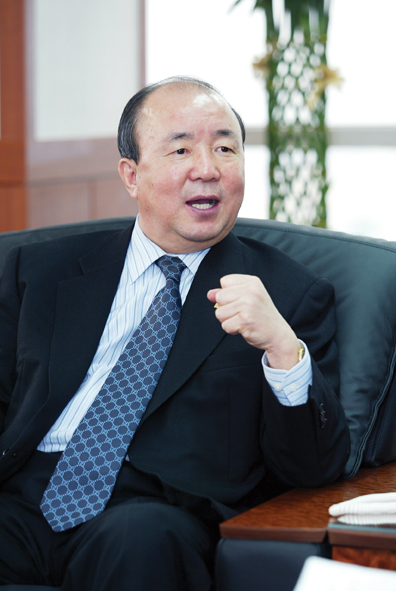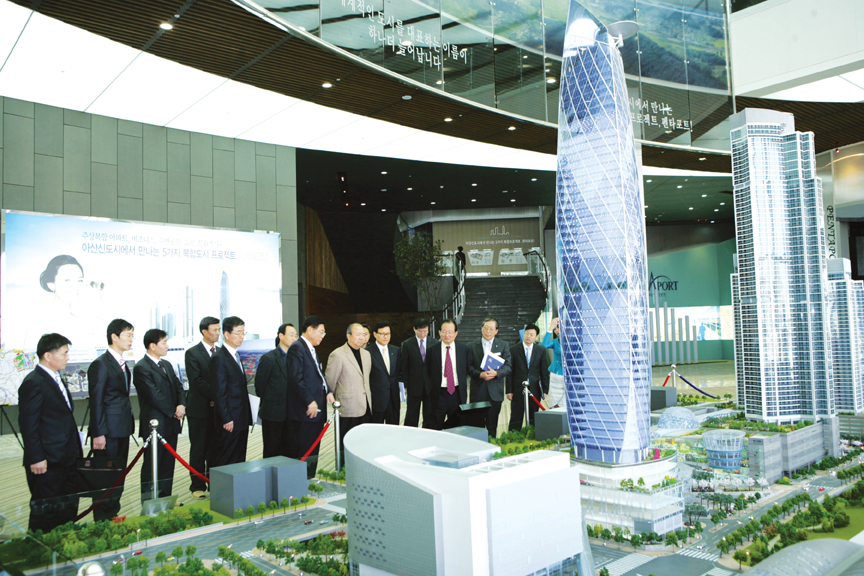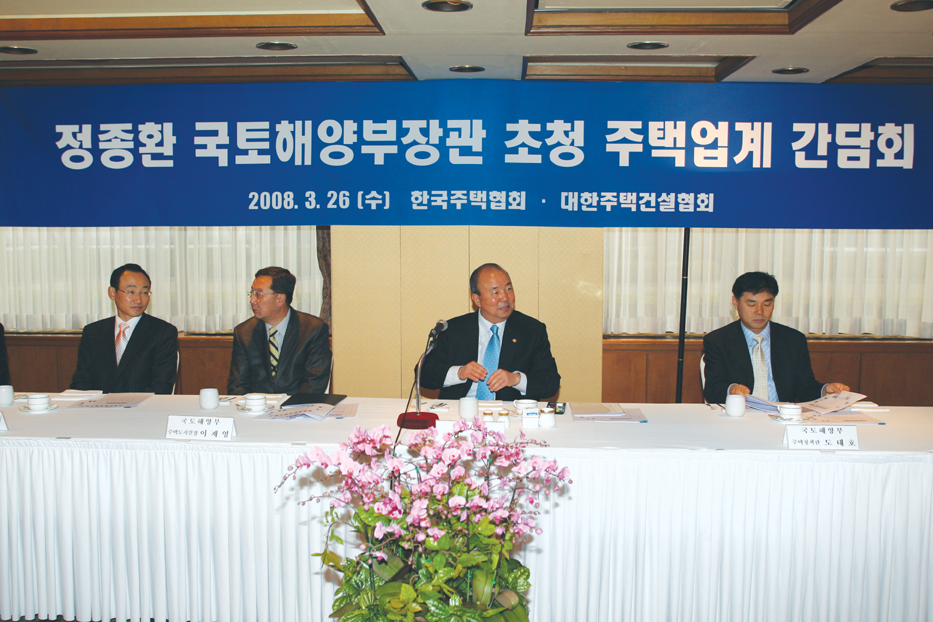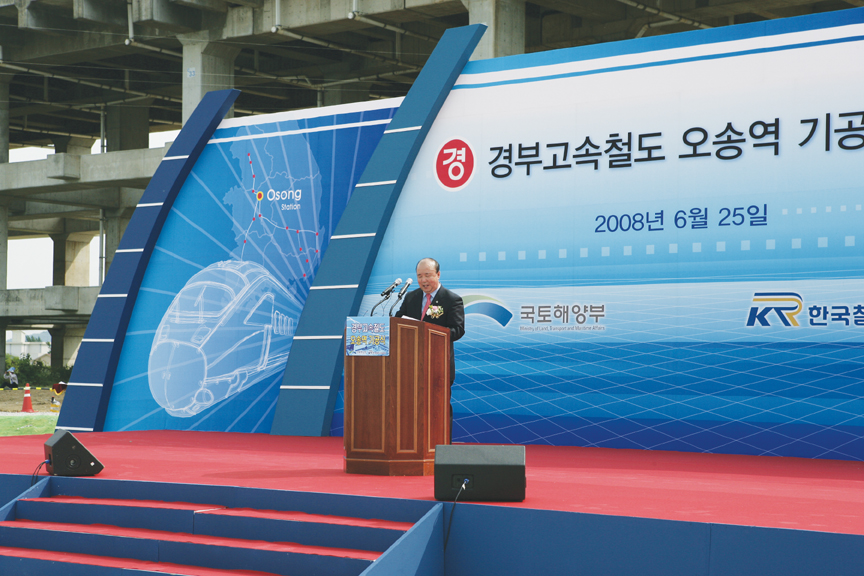IIA Emerges as
International Logistics Hub
Gov't considers third expansion upon completion of the second expansion
 Minister of Land, Transport and Maritime Affairs Chung Jong-whan said, "The government sees the need for pushing the Incheon International Airport Expansion Phase III project as the number of annual travelers using the airport is predicted to surge to 4.63 million passengers by 2015, beyond the capacity of the just-opened second phase facilities." "Examining the outcome of a survey being commissioned for reestablishing the master plan for the airport, it will determine the details, including the timing of implementing the third expansion project, calling for the construction of a second passenger terminal and another boarding building,"he said.
Minister of Land, Transport and Maritime Affairs Chung Jong-whan said, "The government sees the need for pushing the Incheon International Airport Expansion Phase III project as the number of annual travelers using the airport is predicted to surge to 4.63 million passengers by 2015, beyond the capacity of the just-opened second phase facilities." "Examining the outcome of a survey being commissioned for reestablishing the master plan for the airport, it will determine the details, including the timing of implementing the third expansion project, calling for the construction of a second passenger terminal and another boarding building,"he said.
Incheon International Airport (IIA), recognized as the best airport in the world in terms of services for the third straight year, has evolved into a logistics hub as it handled 2.31 million tons of cargo in 2006 to rank second in the world following Hong Kong's Chek Lap Kok, which processed 3.58 million tons of cargo.
 The government's plan to develop the Incheon International Airport area into an international hub of logistics, business and leisure is to provide one-stop logistics and quality living conditions by connecting port, airport and a free economic zone (FEZ), Chung said. The Ministry of Land, Transport and Maritime Affairs (MLTM) also plans to build up an air logistics network connecting five oceans and six continents by raising the number of airlines operating from IIA, flight destination cities and international flight routes from the current 69 airlines, 157 cities and 271 routes to 100 airlines, 200 cities and 400 routes by 2012, he said.
The government's plan to develop the Incheon International Airport area into an international hub of logistics, business and leisure is to provide one-stop logistics and quality living conditions by connecting port, airport and a free economic zone (FEZ), Chung said. The Ministry of Land, Transport and Maritime Affairs (MLTM) also plans to build up an air logistics network connecting five oceans and six continents by raising the number of airlines operating from IIA, flight destination cities and international flight routes from the current 69 airlines, 157 cities and 271 routes to 100 airlines, 200 cities and 400 routes by 2012, he said.
The following are excerpts from a written interview which MLTM Minister Chung gave to NewsWorld. He touched on the direction of major policies in Korean aviation, overseas construction, shipping and other key industries.
Question: Will you tell our readers about the current status of Korea's overseas construction industry and steps to improve its international competitiveness?
 Answer: Korea landed $25.9 billion worth of orders from overseas in the first half of this year after breaking the $20 billion barrier in the first 62 days of the year, the shortest period in the Korean construction history. Korea is forecast to achieve this year's target of $45 billion worth of overseas orders. The value of orders the Korean contractors landed from overseas surged from $7.5 billion in 2004 to $10.9 billion in 2005, followed by $16.5 billion in 2006 and $39.8 billion in 2007. Korea's share in the global construction market edged up from 1.2 percent (ranking 13th) in 2006 to 2.9 percent in 2007 to place 11th in the world, according to the data released by the Economic Research Network (ERN).
Answer: Korea landed $25.9 billion worth of orders from overseas in the first half of this year after breaking the $20 billion barrier in the first 62 days of the year, the shortest period in the Korean construction history. Korea is forecast to achieve this year's target of $45 billion worth of overseas orders. The value of orders the Korean contractors landed from overseas surged from $7.5 billion in 2004 to $10.9 billion in 2005, followed by $16.5 billion in 2006 and $39.8 billion in 2007. Korea's share in the global construction market edged up from 1.2 percent (ranking 13th) in 2006 to 2.9 percent in 2007 to place 11th in the world, according to the data released by the Economic Research Network (ERN).
The overseas construction industry, which set an annual record high of more than $30 billion in new orders from overseas last year, is sure to usher in an era of landing overseas orders worth more than $40 billion, emerging as one of the key export industries together with the semiconductor and the automobile industries,
 whose export values are projected to grow to $29.1 billion and $24.7 billion, respectively. The accumulative value of orders Korea landed overseas soared from $100 billion in 2003 to $200 billion in 2006 and will reach $300 billion during this year.
whose export values are projected to grow to $29.1 billion and $24.7 billion, respectively. The accumulative value of orders Korea landed overseas soared from $100 billion in 2003 to $200 billion in 2006 and will reach $300 billion during this year.
A boom in the overseas construction industry is owed to brisk activities in construction markets in the Middle East, Asia and Africa, an increase in Korea's selective securing of value-added orders and collaboration between the Korean industry and government.
On July 4, the ministry came up with a package of comprehensive steps to provide support to the overseas construction industry in order to sharpen its competitive edge and maintain the growth of the industry in the future. The steps include, among others, expanding support for such value-added areas as R&D investments, diversifying strategies designed to explore foreign markets, including the linking of construction projects to resources exploration, supplying high-caliber manpower and extending financial support.
 About 700 experts will be fostered through new training courses administered by the Korea Institute of Construction Technology and other institutions, while the MLTM is now consulting with the Ministry of Planning and Finance for a plan to invest 5 billion won in a projected infrastructure fund.
About 700 experts will be fostered through new training courses administered by the Korea Institute of Construction Technology and other institutions, while the MLTM is now consulting with the Ministry of Planning and Finance for a plan to invest 5 billion won in a projected infrastructure fund.
The government plans to push ahead with steps to advance all segments of the construction industry, including the industrial sector/business area, placement of orders and guaranteeing system. With the private sector taking the initiative, the committee for the advancement of the construction industry is in place.
Q: Will you elaborate on the completion of the Incheon International Airport Phase II project and its impact on the improvement of infrastructure and the planned Phase III expansion project?
A: Incheon International Airport has evolved into a hub port as it handled 2.31 million tons of cargo in 2006 to rank second in the world following Hong Kong's Chek Lap Kok Airport, which processed 3.58 million tons of cargo. In particular, Incheon International Airport's transshipment cargoes accounted for 50.1 percent of the total cargoes handled by the airport. The number of airlines operating at the airport and their flight destinations increased from 47 airlines and 109 cities at the time of the opening of the airport to 59 airlines and 160 cities in 2007. The airport was presented with the Best Airport Worldwide Award for the third year in a row.
The government sees the need for pushing the Incheon International Airport Expansion Phase III project as the number of annual travelers using the airport is predicted to surge to 4.63 million in 2015 beyond the capacity of the just-opened second phase facilities. Examining the outcome of a service being commissioned for reestablishing the master plan for the airport, it will determine the details, including the timing of implementing the third expansion project, calling for the construction of a second passenger terminal and another boarding building.
Q: Will you describe the plan to realize the goal of making Korea a global logistics powerhouse by unifying the logistics systems together with the completion of the Incheon International Airport Phase II project?
A: One of the MLTM's major tasks is to maximize the synergetic effects by unifying systems for implementing land, maritime and air logistics policies.
Separate logistics administration systems have been so far left unconnected among land, air and maritime logistics policies. For instance, even though Busan's New Port and Gwangyang Port in the Gwangyang Bay have already been opened, they suffered a setback since their land transportation networks in backwater areas have yet to be in place. In the past, administrative work on logistics companies, separately divided by the then Ministry of Construction and Transportation (MOCT) and the then Ministry of Maritime Affairs and Fisheries (MOMAF), were not provided on a one-stop basis.
The MLTM, through a merger of the former MOCT and the MOMAF, plans to focus on the systematic linkage of land, air and maritime logistics policies. To this end, it will advance land and railway connections of airports and seaports while establishing by the end of this year a plan to connect 300-odd transportation logistics deficiencies.
The ministry is building up a national logistics integration information center, committed to providing integrated information on land, maritime and air logistics during the period between 2008 and 2011 so that companies can acquire them conveniently anytime and anywhere for their business activities.
It plans to provide support for expanding such faster and cheaper sea-land-air logistics transportation systems among Korea, China and Japan as the Korean-Chinese Road Feeder System (RFS) and the Korean-Japanese Rail-Sea-Rail (RSR) service. In particular, Korea, China and Japan agreed to expand tripartite cooperation at the second Korea-China-Japan logistics ministerial meeting held in Okayama, Japan on May 17.
The MLTM plans to take diverse steps to build up a seamless logistics system by relieving bottlenecks.
Q: Do you have any plan to foster Korean logistics companies into the likes of DHL and TNT's Will you tell us about the current status of the maritime logistics industry and the government's plan to develop the air logistics industry?
A: The global logistics market has been restructured by such super mega-companies as Deutsche Post World Net (DPWN), the parent company of express services and logistics services provider DHL, UPS and TNT, which have been expanding their dominance via M&As and strategic alliances.
The nation needs to cultivate logistics majors in order to develop Korea into a global logistics powerhouse. In order to attain this goal, the government strives to employ diverse steps, including an overhaul of an integrated logistics company certification system, support for takeover bids among Korean logistics companies or between Korean and foreign companies and support for exploring foreign markets by making the most of Korean logistics investment funds.
The government is scrambling to provide support for developing Korean logistics companies into global top 10 logistics firms by 2012. In recent years, such logistics companies as Hanjin, CJ and GLS keep on growing with an annual average growth rate of from 8 percent to 15 percent. I bet that the chances are high that Korean logistics companies will emerge as global players if their self-rescue efforts and the government's steps to shore up the Korean logistics industry have synergetic effects.
It plans to strengthen the competitiveness of the Korean shipping industry, which served as one of the nation's top five foreign exchange earners with $27.7 billion worth of revenues in 2007 as well as that of the domestic aviation industry, including Korean Air, which ranked number one in terms of handling cargo for three consecutive years from 2004 to 2006.
Such advanced shipping systems as a shipping fund investment system and a tonnage-based tax system have been introduced to boost the shipping industry. Korean shipping companies have more room to make investments due to a boom in the industry that has been prevailing since 2003.
Korea has seen the number of national flag-carrying ships and gross tonnage rising from 546 ships with 13.72 million tons in gross tonnage in 2005 to 718 ships with 18.04 million tons in gross tonnage to rank sixth in the world, representing a 3.6 percent share in the global shipping market. The industry has become one of the nation's top five foreign exchange earners together with the semiconductor, automobile, wireless communication devices and shipbuilding industries by posting a yearly average of $3 billion trading service surplus, contributing to easing Korea's chronic deficit in the service industry.
The government plans to work toward the revamping of tax and other systems related to the shipping industry and help shipping companies diversify their business portfolios, including ship transactions, chartering and leasing, while laying a legal foundation for fostering such added value services as ship insurance, brokerage and maritime arbitration services and invigorating the shipping financing industry.
It strives to attract investments by multinational logistics companies into the IIA logistics complex for the purpose of the development of the aviation logistics industry while a project to develop 922,000 square meters into an expansion of the logistics complex gets underway. A tourism/leisure cluster, dubbed "Air-City"is being developed in the vicinity of the international airport. The government's plan to develop the IIA area into an international hub of logistics, business and leisure is to provide one-stop logistics and quality-living conditions by connecting the port, airport and free economic zone (FEZ). The government also plans to build up an air logistics network connecting five oceans and six continents by raising the number of airlines operating from Incheon International Airport, flight destination cities and international flight routes from the current 69 airlines, 157 cities and 271 routes to 100 airlines, 200 cities and 400 routes by 2012.
Q: Korea played host for the 8th World Congress on Railway Research (WCRR) 2008 from May 18-22, with about 700 people from 35 countries in attendance. What is the current status of Korea's development of railway-related technology and exploring foreign markets?
A: Under the theme "Towards a Global Railway,"286 papers were presented and 126 exhibitors showcased their latest technologies and products during the exhibition. They served as opportunities for participants to share railway technology and explore ways of shaping the future of the railway industry.
About 350 representatives from the railway institutions of 36 countries participated in the 72nd General Assembly of the Union Internationale Chemins De Fer (UIC), which coincided with the WCRR 2008, to further cement a global network. IRaTCA, International Railway Training Center for UIC Asia, which was designed to cultivate railway manpower in Asia, was established at the Korea Railroad (KORAIL) during the conference, held for the first time in Asia.
Korea became the fourth country in the world to develop a high-speed railway with a speed of 350 km per hour and succeeded in the development of a tilting train with a speed of 180 km per hour, designed to improve the speed of the existing lines. The nation is in the process of developing a next-generation high-speed train with a speed of 400 km per hour during the period between 2007 and 2013.
The ministry provides multi-channel support for helping companies with excellent technologies make an inroad into the global railway market by dispatching market exploration groups, inviting representatives of foreign companies who place orders and operating a joint government-private sector consultative committee for supporting foreign market exploration.
Q: Will you tell us about the current status of the Gyeongbu High-speed Railway and the plan to build the Honam High-speed Railway?
A: The first phase section of the Gyeongbu (Seoul-Busan) High-speed Railway line made its debut in April 2004, raising Korea's railway standing as a global railway powerhouse to rank Korea as the fifth country in the world to operate a high-speed railway system. Construction of the 409.8 km-long Seoul-Daegu section -- a 238.6 km-long newly-built line and a 171.2 km-long conventional line -- cost 12.73 trillion won. The Gyeongbu High-speed Railway Phase II project gets underway with 49.2 percent of the process complete and the second phase line -- the 124.2 km-long Daegu-Busan section and the 43 km-long Daejeon and Daegu downtown sections -- is to be dedicated by 2010 at a cost of 7.21 trillion won.
The Honam High-speed Railway project that began in August 2006, calls for the construction of a 230.9 km-long line linking Osong and Mokpo at a cost of 10.46 trillion won. The design process is underway with 70.6 billion won allocated in the government's budget for this year, and the project will break ground in the second half of next year.
Q: Will you explain the mid- and long-term plans to construct expressways and expressway projects that are to be completed or break ground within this year?
A: The ministry plans to build up a 6,000 km-long expressway network that can be reached from any place across the nation within 30 minutes. The network will be continuously expanded in a grid of nine trunk roads running from east to west and seven artery roads running from north to south. In an effort to address soaring traffic demand in the Seoul metropolitan and Chungcheong Province areas, the implementation of urgent lines will be given priority under a plan for the Seoul metropolitan expressway network and, to this end, the ministry will secure necessary funds from the national coffers and attract investments from the private sector and public organizations.
A 3,000 km-long expressway network was already built up across the nation by the end of 2006, and government budgets will be intensively poured into the ongoing expressway projects to extend the total length of the expressway network to about 4,000 km by 2011.
Within this year, three lines with 79.3 km in combined length -- the 21.2 km-long Pyeongtaek-Eumseong Line, the 10.9 km-long Muan-Gwangju Line and the 47.2 km-long Busan-Ulsan Line -- will be dedicated or opened to traffic. The Pyeongtaek-Eumseong and Muan-Gwangju lines will complement the artery network running from east to west more sufficiently than the trunk network running from north to south, cutting down on logistics costs by 332.2 billion won yearly and contributing to the development of inland regions. The Busan-Ulsan Line, linking Busan Metropolitan City and the Ulsan Industrial Complex, will cope with a rise in traffic demand in the eastern and southern spheres and contribute to easing traffic congestion on national roads No. 7 and No. 14, thus reducing logistics costs by 1.25 trillion won yearly.
Five new expressway projects will break ground within this year. A project to build a 71.7 km-long expressway linking Donghongcheon to Yangyang will be launched to connect with the Seoul-Chuncheon-Donghongcheon Expressway, whose construction is underway. Three projects with private sector investments -- the 42.6 km-long 2nd East Coast Expressway between Pyeongtaek and Siheung, a 28.6 km-long Incheon-Gimpo expressway and a 21.8 km-long Anyang-Seongnam expressway -- will be launched.
Q: Is there any plan to integrate or disband public organizations under its control?
A: The government is drawing up ways of advancing the management of public organizations in order to raise their efficiency and step up their competitive edge. Diverse options, including privatization, integration/disbandment and ways of making management more efficient are being studied, but no details have yet to be finalized. It plans to adopt options considered to be the most rational and minimize any side effects by scrutinizing the character of each organization, cases of foreign countries and experts'views.
Q: What has caused the truck unionists'general strike and what steps are you taking to prevent a recurrence of such a strike?
A: The general strike was prompted by truck owners/operators who had to bear additional burdens cause by crude oil price hikes under a multi-channel structure involving cargo owners, agents, transportation companies and truck owners/operators, coupled with a chronic glut of trucks, estimated at 22,000 in 2007. GAs prices surged from 1,435 won per liter in December 2007 to 1,910 won in June 2008.
The government has come up with diverse steps to provide support in an effort to ease the truckers'burden caused by the rise in fuel costs. They include the extension of the period for the payment of an oil price subsidy from June 2008 to June 2009, subsidizing half of the fuel price increases (1,800 won per liter). Furthermore, nighttime discount on the expressway toll charge will be expanded, which was granted to trucks of more than 10 tons, to include those of less than 10 tons effective as of July 2008.
It plans to institutionalize a standard wage system so that appropriate wages can be realized for cargo owners and logistics companies to share the additional burden that will take effect in 2009. An ad hoc committee for inducing the standard wage system will be formed at the Prime Minister's Office and a study will be commissioned.
New truck owners/operators have been banned from entering the truck transportation market since 2004 to stabilize demand and supply in the market. The government is considering taking fundamental steps to prevent a recurrence of such a strike. It will set aside 100 billion won to cut the fleet of trucks by 3,600 between 2008 and 2009 in a bid to ease the oversupply, while earmarking 50 billion won to supply 500 liquefied natural gas trucks during the same period in order to restructure the market. A task force has been formed to work out steps to revamp the truck transportation market, and decisions will be announced by this December. nw
Minister of Land, Transport and Maritime Affairs Chung Jong-whan
SHORING UP LOGISTICS - MLTM Minister Chung holds a meeting with representatives of the logistics industry.
(Above) MLTM Minister Chung inspects a construction site of a new city project in Asan while discussing with representatives of the housing industry ways to solve difficulties facing the sector.
MLTM Minister Chung speaks at a ceremony to launch a project to build the Osong Station that will link the Gyeongbu (Seoul-Busan) and the planned Honam High-speed railways on June 25, 2008.
3Fl, 292-47, Shindang 6-dong, Chung-gu, Seoul, Korea 100-456
Tel : 82-2-2235-6114 / Fax : 82-2-2235-0799